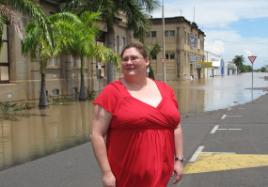Flood could leave big health impact in its wake
Published on 06 January, 2011
As the flood waters peak in Rockhampton a CQUniversity environmental health expert warns of the dangers that await as the waters recede.
Sewerage, oils, chemicals and industrial waste may make their way into the Fitzroy River according to Lisa Bricknell, who says flood waters are no place for people.

Lisa Bricknell awaits the health impact of the Rockhampton flood.She said that the problem is not only the height of the flood waters but the length of time the waters will stay up.
"There is a high risk of water contamination. Even though the sewerage treatment plant is currently functioning, the large amounts of water entering the plant may force the plant to release sewerage waters that would normally be unacceptable for the river.
"Undoubtedly there would be industrial contaminants also flowing through the waterways at the moment. Although industrial sites adhere to set processes for contaminants in normal situations it would be difficult for such contaminants to not be able to flow into the water at present."
However, the biggest health problem may emerge as the waters drain away from properties with the influx of mosquitoes and their range of diseases such as Barmah Forest and Ross River viruses.
"The Summer months are when mosquito born viruses regularly appear in the community in normal circumstances.
"With the amount of water that we have now and will continue to have for some weeks, I foresee a real health threat to Central Queenslanders with numbers of people presenting with mosquito born viruses set to rise."
Ms Bricknell has suggested people be vigilant in protecting themselves from mosquitoes in coming weeks by wearing long sleeve shirts and long pants when outdoors and also by applying insect repellent regularly.
She also suggested that people in non-flood affected areas remove any excess water from their properties to prevent mosquitoes from breeding. This could include blocked drains and even self-watering pot plants.
As water tanks are also a great breeding spot for the insects, she has suggested using vegetable oil on the water's surface and ensuring mosquito netting on all inlets and outlets are in good condition to stop mosquitoes accessing the water.
As the huge clean-up task begins in the region, she has also suggested appropriate protective clothing and disinfectants be used to protect individuals from contaminants and also to ensure living areas are cleaned thoroughly.
Disinfectants and chlorine-based mould killers should be used to clean down properties that have been underwater to ensure the properties are safe for families to return home. Ms Bricknell warns that mould after flood events can cause some nasty respiratory diseases.

